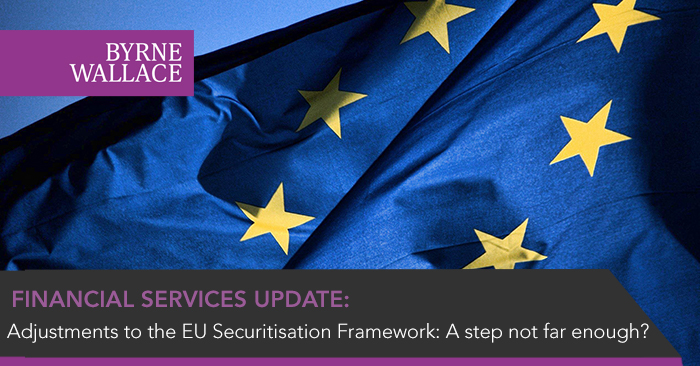Adjustments to the EU Securitisation Framework: A step not far enough?
Monday, 09 November 2020
Although not even in force two years at this point, a number of significant amendments to the EU’s Simple Transparent Securitisation (“STS”) regime have been proposed earlier in 2020 and are currently under active consideration by EU legislators. This reflects an effort on the part of policy-makers to try improve those rules and ensure that securitisation can be among the tools used by market participants to help the region emerge from the profound economic shock wrought by COVID-19 from March 2020 onwards.
While the subject of much consideration prior to their entering into effect in January 2019, and not due for formal review until 2022, the STS regime has not proven the success hoped for, with securitisation volume falling year-on-year since the regime was first issued - the Association for Financial Markets in Europe reports that Loan Portfolio sales have fallen steadily from a market high of €182.5bn (2018) to a low of €28.7bn in the first half of 2020.1
In this update we provide a short recap on the STS rules which entered into effect in 2019 and an overview of some of the key elements of reform under consideration, their status, and some commentary on how effective the proposal may prove to be in practice.
What are the existing rules?
The principal element of existing EU rules on securitisations, Regulation EU 2017/2402 (the “STS Regulation”) came into force on 1 January 2019. The STS Regulation introduced a range of requirements designed to simplify, or at least standardise, rules associated with securitisations which where, at that time, to be found in a number of regulatory regimes, including the CRR2, the Solvency II Directive, AIFMD, not to mention a myriad of national regimes and practices.
The STS addressed everything from re-securitisations (with various prohibitions) to sales to retail investors (allowed only in very limited circumstances), but in the main addressed the following key elements:
(A) Credit Granting Criteria – including ensuring that an original lender’s credit granting criteria have been followed in creating the assets to be securitised;
(B) Risk Retention – requiring that originators, sponsors and/or original lenders retain some element of risk in assets securitised, in accordance with a “direct approach”, “indirect approach”, etc.;
(C) Transparency – imposing a unified, clear, though extensive set of disclosure obligations on those responsible for the securitisation concerned in terms of pricing, loan level data, etc., in the form of prospectuses, via securitisation repositories, etc.; and
(D) Due Diligence – creating aligned requirements on various classes of institutional investors for review prior to taking on a securitisation position.
Although much was to be commended in the STS Regulation, and in particular its seeking to align rules applying across various sectors (insurance, banking, and investment services), the regime clearly remained incomplete and even prior to the economic impact of the COVID-19 spreading across European economies, policy-makers were considering what reforms to the STS Regulation, and relevant regimes, should be proposed.
Amendments proposed
The proposed amendments have come in the form of a European Commission proposal and follow on from the publication of a report from the European Banking Authority (the “EBA”). The EBA has recently concluded investigations into amending the STS Regulation and related requirements and recommended their amendment to provide for sympathetic treatment of on-balance-sheet synthetic securitisation (previously largely excluded from scope), and reduced constraints to the securitisation of non-performing exposures which are embedded in the current framework. Such proposals are quite detailed, reflect detailed work on the part of market participants, the EBA, and the European Commission and can be summarised as follows:
(1) On-balance sheet synthetic securitisation – a first element of the reforms would see on-balance sheet synthetic securitisations fall under the purview of the STS Regulation for the first time, subject to their meeting certain criteria, in the hope that this will result in a more extensive use of EU securitisation markets;
(2) Non-performing exposures – a second core element of the proposed amendments would see risk retention and credit granting requirements of the STS Regulation reworked to provide for specific requirements for verification duties on originators and other related parties regarding securitising non-performing exposures. A related reform would see the requirements linked to the CRR reformed so as to provide more effective treatment of non-performing exposures to better allow institutions offload non-performing exposures and not be, effectively, penalised for doing so through risk retention and capital requirements; and
(3) Minimum credit rating – a third element of what is proposed would see the requirement for unfunded credit protection introduced, in a marked divergence from the current requirements.
Relevant amendments were proposed by the European Commission in a measure published on 24 July 2020 and as part of the Commission’s Capital Markets Recovery Package. Such is subject to the ordinary legislative procedure pursuant to Article 114 of the Treaty on the Functioning of the European Union. If approved by the European parliament, relevant proposals (with proposed amendments) will be presented to the Commission and Council for further consideration, with a final form regulation published in the Official Journal of the European Union (potentially further amended) thereafter. It is not possible to estimate when relevant reforms might be implemented but from the Commission’s public statements we understand that implementation is sought sometime in 2021 at the latest.
Consideration
While much is to be welcomed in the Commission’s proposals, the final form of relevant rules is not yet clear and existing provisions, to the extent they remain unamended, will continue to act as a bar on the effective use of securitisation as a tool to share, mitigate, and effectively price risk. Indeed, certain proposals from the European parliament to limit the application of the STS framework to “significant” on-balance sheet risk transfers will act as a brake on that element of the securitisation market, albeit it is not wholly clear the public benefit obtained. All in all, the Commission’s effort (and that of other policy makers) is to be welcomed, but whether or not this proves to be an effective spurn to enhance the effectiveness and use of securitisations in the EU remains to be seen.
How can ByrneWallace help?
ByrneWallace are experienced in helping banks, asset managers, investors, and other stakeholders in facilitating securitisations, and understanding requirements which apply, whether they be imposed by the STS Regulation or otherwise. ByrneWallace’s multi-disciplinary teams in Corporate, Banking and Finance, and Taxation have experience in managing all aspects of the securitisation process and would be happy to assist in helping navigate the process, whether you are an experienced market participant, or enterprise considering aspects of this useful, effective and evolving financial practice for the first time.
.
For further information or advice, please contact the ByrneWallace Financial Services group.
1 See Association of Financial Markets in Europe “AFME report tracks European capital markets performance in 2020” (October 28th 2020), copy available at this link: https://www.afme.eu/news/press-releases/details/AFME-report-tracks-European-capital-markets-performance-in-2020
2 Regulation (EU) 575/2013

